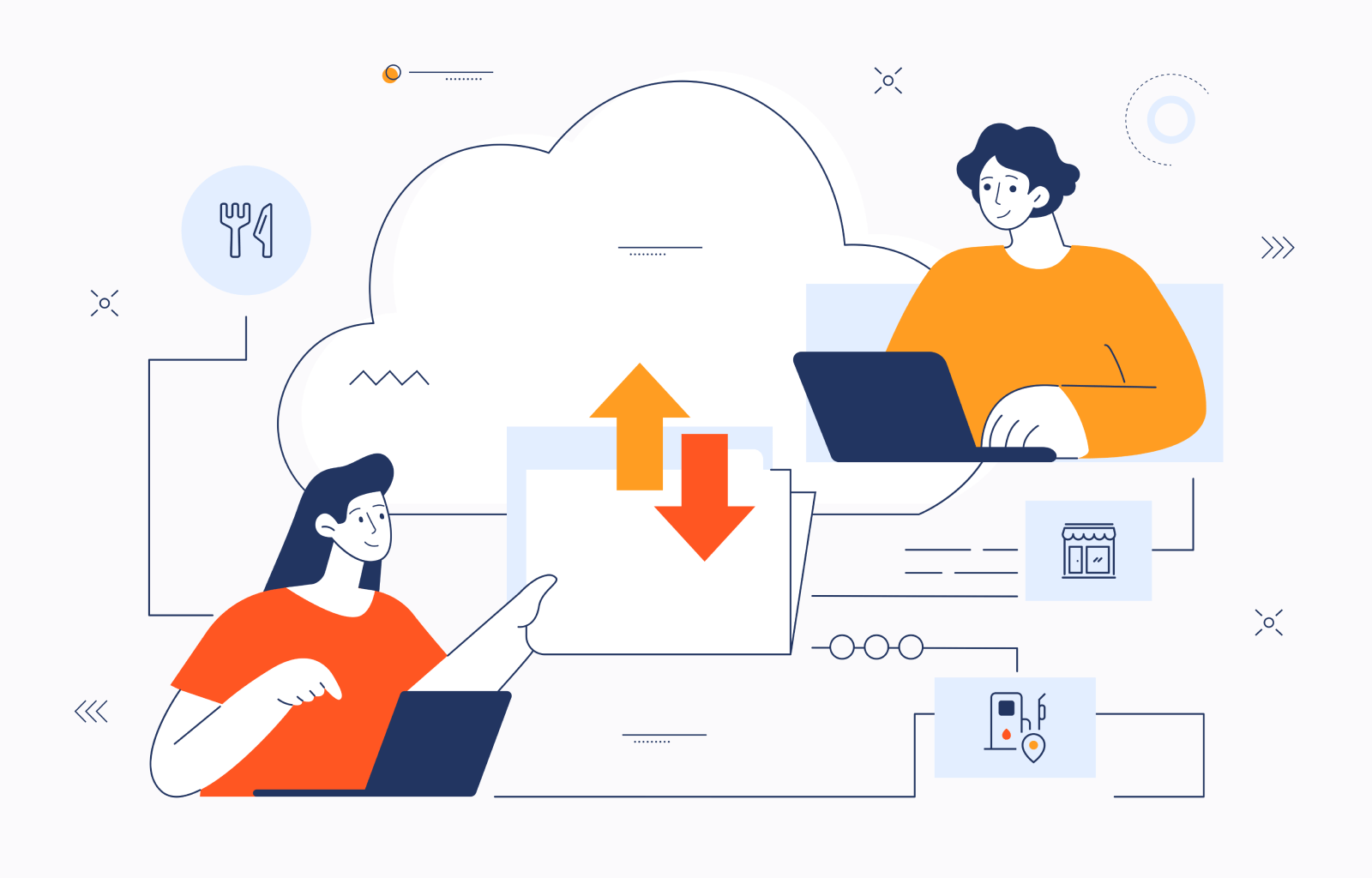How Grocery Stores, Gas Stations, and QSR Chains Use Data-Sharing Software for Cross-Industry Customer Engagement

Picture this: a customer shops at your grocery store, fuels up at a nearby gas station, and grabs a bite at a fast-food restaurant — all in one go. Each stop generates lots of data, but here’s the thing... If all that information is locked within each business, you’re basically leaving money on the table.
Luckily, data-sharing in retail, fuel, and quick-service restaurant (QSR) industries can save the day. How so? It lets businesses offer seamless, personalized experiences that keep customers coming back. No wonder 89% of businesses surveyed by Twilio in 2024 say personalization is key to their success in the next three years.
In case you want to succeed, too, and serve up exactly what your customers crave, stick around. We’re about to discuss how cross-industry collaboration can boost engagement, loyalty, and, ultimately, revenue.
The Growing Need for Cross-Industry Collaboration
Your customers don’t live in isolation, and neither should your business.
Think about your own day. You might grab a coffee on your way to work, pick up groceries on your lunch break, and fill up your tank before heading home. That’s a typical day for many people, and it shows how seamlessly our lives intertwine between different industries.
But why are businesses still working like they’re in separate bubbles?
The truth is that grocery stores, gas stations, and QSR chains all have pieces of customer information. Yet, they are still looking for means to exchange that data without extra hassle. When they succeed, they can build a much clearer picture of who their customers are, what they want, and when they want it. Just imagine:
Grocery stores that understand their customers’ habits and offer discounts on relevant products.
Gas stations that anticipate customer fuel needs based on their driving patterns.
QSR chains that offer data-driven promotions that match their customers’ dietary preferences.
In fact, customers expect this level of personalization. They’re tired of generic offers and irrelevant promotions. A 2024 study revealed that 64% of consumers prefer to buy from companies that tailor their experiences to individual wants and needs.
Despite this apparent demand, many businesses struggle to deliver the personalization level their customers want. According to Medallia, only 23% of consumers reported experiencing high levels of personalization after recent hotel stays, and just 26% felt the same after retail interactions.
QSR, fuel, and retail data collaboration can fill this gap — particularly with the right software.
Key Challenges of Data-Sharing Across Industries
If cross-industry customer engagement was easy, everyone would be doing it. But connecting grocery stores, gas stations, and QSRs comes with its fair share of challenges. Here are the main ones:
Data silos. Each business collects customer data, but most stays in separate systems — like your grocery store’s loyalty program, a gas station’s payment records, or a QSR’s order history. In such circumstances, you might miss out on the bigger picture of how your customers interact across industries.
Privacy and compliance issues. Sharing retail, QSR, and gas station customer insights isn’t that simple. You’ve got legal responsibilities to follow, including GDPR, CCPA, and other data privacy laws, depending on where you run your business. If you fail to comply, this can lead to fines, undermined trust, and legal issues.
Technology barriers. Many businesses still use outdated systems that weren’t designed for data-sharing. Legacy software, incompatible databases, and a lack of real-time connectivity make data exchange challenging.
Lack of standardization. Even if you get past the tech barriers, you may find data-sharing difficult because there’s no universal format. One company may categorize a customer as “loyal,” while another tracks “high spenders” — but are they the same? Without a common ground, exchanging data is somewhat chaotic and confusing.
How Data-Sharing Software Solves These Challenges
We’ve covered the hurdles — data silos, privacy concerns, outdated systems, and the lack of standardization. Now, let’s discuss how to solve them. Here are the tools that can help:
Customer data platforms (CDPs). A CDP is a software solution that brings all customer data to one place. It collects and stores information from loyalty programs, mobile apps, payment systems, and third-party sources — so you get a full view of your customers. With such software, different businesses can exchange consumer behavior insights and create unified customer profiles for better cross-industry engagement.
AI-powered analytics. Collecting all that data is great, but what do you do with it? Use AI in retail marketing, QSR promotions, and gas station offerings. With AI tools, you can analyze customer behavior and preferences, personalize recommendations, and even predict future purchases.
Secure API integrations. Remember those tech barriers? APIs are a way to enable data exchange between different systems without compromising privacy. With the right integrations, you can sync data from your fellow businesses in real time.
Blockchain. This technology creates a decentralized, tamper-proof ledger of transactions, which makes your system less susceptible to changes or hacking.
Examples of Data-Sharing in Retail, Fuel, and QSR Industries
By now, you see that collaboration and digital transformation in retail, fuel, and QSR industries really make a difference. But what does it look like in action? Let’s go through some examples:
Loyalty Programs that Cross Industry Boundaries
Think of a single loyalty program that works across grocery stores, gas stations, and fast-food restaurants. Customers could earn points while grocery shopping, use them for discounts at the pump, and redeem rewards at their favorite QSR — all within the same network.
Some programs already make this a reality. For example, Exxon and Mobil gas stations offer Walmart+ members a 10¢/gallon fuel discount.
Personalized Promotions & Targeted Marketing
Generic coupon discounts typically end up in the trash. Yet, with QSR, gas station, and grocery store data analytics, you can come up with personalized offers and omnichannel marketing strategies that match real buying behaviors.
For example, if a customer regularly buys coffee while fueling up, they might receive a coupon for a free pastry with the next purchase. A grocery store can partner with a QSR to offer discounts on meal kits to customers who frequently buy fast food.
Real-Time Inventory & Supply Chain Optimization
Data-sharing isn’t just about personalized marketing in retail, fuel, and QSR. It’s also about streamlined operations. Businesses that exchange insights with each other can optimize inventory, reduce waste, and generally make their supply chains more efficient.
For instance, a fast-food restaurant may partner with a grocery store to order ingredients during peak hours.
Enhancing the Customer Journey with AI
To make the customer journey even more efficient and increase retail, fuel, and QSR customer loyalty, businesses in these three industries can leverage AI. How exactly? Artificial intelligence can be used to analyze massive amounts of data in real time, predict customer behavior, and optimize decision-making.
Take AI-powered drive-thru recommendations, for example. A QSR can analyze a customer’s past orders (at any participating location) and suggest tailored meal options right when a customer pulls up. Or a gas station can use AI to predict when a customer might need a refill — sending them a discount offer just before they hit empty.
Why Does Data-Sharing Matter?
At the end of the day, customers don’t see separate industries. They simply follow their daily routines. They shop at grocery stores, fuel up their cars, and grab meals in their favorite QSR chains. And while they travel from place to place, your business needs to move with them.
As we discussed today, the best way to do this is by adopting reliable data-sharing software. With this solution, you can tackle data silos to offer smarter promotions, better rewards, and smoother customer experiences. Ultimately, you’ll see the impact yourself — stronger relationships and increased revenue.
And if all this discussion about data integration, APIs, AI, loyalty programs, and data sharing has your head spinning, don’t worry. Reach out to Integrio Systems for an expert consultation. As a software development company with over 20 years of experience in retail, manufacturing, transportation, and beyond, we know how to implement robust data-sharing solutions.
Contact us

